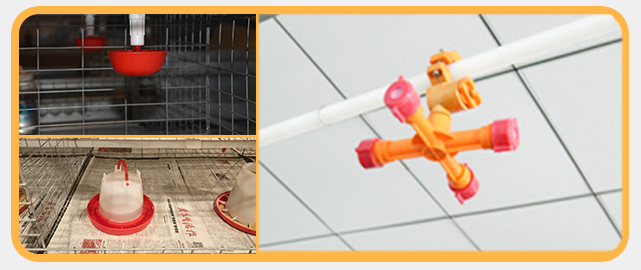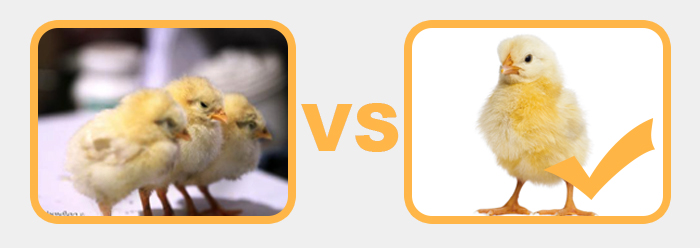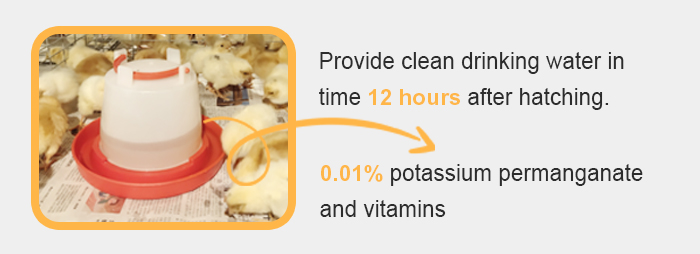Strict Disinfection
Prepare the brooding room before the chicks come. Rinse the trough drinker thoroughly with clean water, then scrub with hot alkaline water, rinse with clean water, and dry. Rinse the brooding room with clean water, lay the bedding after drying, put in the brooding utensils, fumigate and disinfect with 28ml formalin, 14g potassium permanganate and 14ml water per cubic meter of space. Close tightly. After 12 to 24 hours, open the doors and windows for ventilation and preheat the room temperature to above 30°C to allow the chicks to be placed in the brooding room.

Choose Healthy Chicks
Healthy chickens are generally lively and active, with strong legs, free movement, clear eyes, and good navel healing. The sickly chick had dirty feathers, lacked energy, closed his eyes and took a nap, and stood unsteady. When buying chicks, be sure to choose healthy chicks.

Timely Drinking Water
The chicks can lose 8% of water within 24 hours and 15% within 48 hours. When the water loss is greater than 15%, symptoms of dehydration will soon appear. Therefore, the chicks should be provided with adequate and clean drinking water 12 hours after they are out of the shell. In the first few days, drink 0.01% potassium permanganate and water added with multivitamins to disinfect drinking water and clean up the stomach and intestines, and promote meconium excretion.

Well Fed
The feed should have good palatability, easy digestion, fresh quality, and moderate particle size. The chicks can be fed within 12 to 24 hours after they are out of their shells. They can be cooked with broken corn, millet, broken rice, broken wheat, etc., and boiled until they reach eight maturity, which is beneficial to the digestion of the chicks. Feed 6-8 times a day and night for 1~3 days of age, 4~5 times a day after 4 days of age, and 1 time at night. Gradually change the feed to the chicks.

Adjust Temperature and Humidity
Temperature and humidity comparison table:
| Feeding stage (day age) | Temperature (℃) | Relative humidity(%) |
| 1-3 | 35-37 | 50-65 |
| 4-7 | 33-35 | 50-65 |
| 8-14 | 31-33 | 50-65 |
| 15-21 | 29-31 | 50-55 |
| 22-28 | 27-29 | 40-55 |
| 29-35 | 25-27 | 40-55 |
| 36-42 | 23-25 | 40-55 |
| 43-Weed out | 20-24 | 40-55 |
If the chicken house is too wet, use quicklime to absorb moisture; if it is too dry, put a basin of water on the stove to increase the indoor humidity.

Reasonable Density
The size of the density should be adjusted reasonably according to the age of the chicks, the breeding method of the breed and the structure of the chicken house.
|
Feeding density for brooding 0-6 weeks |
||
| Weeks of age | Cage | Flat raise |
| 0-2 | 60-75 | 25-30 |
| 3-4 | 40-50 | 25-30 |
| 5-6 | 27-38 | 12-20 |
Unit: birds/㎡
Scientific llumination
Use 24 hours of light for the first 3 days of the brooding period, and reduce 3 hours per week until the brooding period is fixed. The light intensity is: 40 watt bulbs (3 meters apart, 2 meters high from the ground) for the first week. After the second week, use a 25-watt bulb, with a light intensity of 3 watts per square meter, and uniform illumination. A single bulb does not exceed 60 watts to avoid pecking.

Epidemic Prevention
An unsanitary and humid environment is prone to cause chicken diseases, especially pullorum and coccidiosis. The chicken house should be thoroughly disinfected regularly, kept dry and clean, bedding should be changed frequently, drinking water should be clean, and feed should be fresh.
| Age | Suggest |
| 0 | Inject 0.2 ml of freeze-dried vaccine of Marek’s disease turkey herpes virus. Add 5% glucose, 0.1% vitamins, penicillin and streptomycin to drinking water. |
| 2~7 | Add 0.02% furterine to drinking water, and mix 0.1% chloramphenicol into the feed. |
| 5~7 | Newcastle disease II or IV vaccines are instilled into the eyes and nose according to the prescribed dose. |
| 14 | Marek's vaccine subcutaneously |
| 18 | Injection of bursitis vaccine |
| 30 | Newcastle disease II or IV vaccine |
Note: Sick chickens should be isolated in time, and dead chickens should be kept away from the chicken coop and buried deep.
Fresh Air
Strengthen the ventilation of the brooding room and keep the air in the house fresh. Ventilation in the house can be carried out at noon when the sun is full, and the opening degree of the doors and windows is from small to large and finally half open.

Meticu lous Management
It is necessary to observe the flock frequently and grasp the dynamics of the flock. Reduce stress factors and prevent cats and mice from entering the chicken house.

Post time: Dec-10-2021







